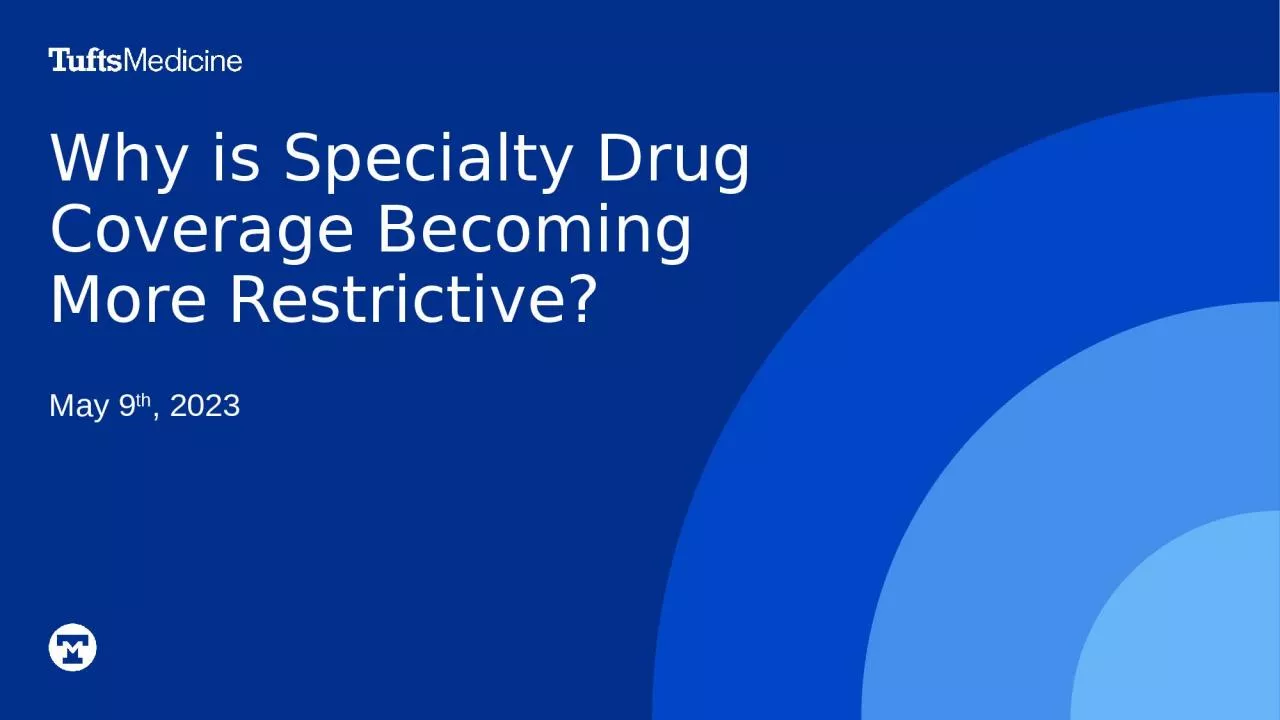

May 9 th 2023 Rochelle Henderson PhD National Pharmaceutical Council James Chambers PhD MPharm CEVR Tufts Medicine Panelists C Bernie Good MD MPH Professor of Medicine University of Pittsburgh ID: 1048479
Download Presentation The PPT/PDF document "Why is Specialty Drug Coverage Becoming ..." is the property of its rightful owner. Permission is granted to download and print the materials on this web site for personal, non-commercial use only, and to display it on your personal computer provided you do not modify the materials and that you retain all copyright notices contained in the materials. By downloading content from our website, you accept the terms of this agreement.
1. Why is Specialty Drug Coverage Becoming More Restrictive?May 9th, 2023
2. Rochelle Henderson, PhDNational Pharmaceutical CouncilJames Chambers PhD, MPharmCEVR, Tufts MedicinePanelistsC. Bernie Good, MD, MPHProfessor of Medicine, University of PittsburghSenior Medical Director, UPMC
3. 18 large US commercial health plans 190+ million covered lives 388 specialty drugs 150+ diseases 100+ biopharma companies 75,000+ coverage decisions 60,000+ citations
4. No restrictionsRestrictionsNot covered39%52%Specialty drug coverage over time (5,065 coverage decisions)* Source. Tufts Medical Center. Specialty Drug Evidence and Coverage (SPEC) Database. Available: https://cevr.tuftsmedicalcenter.org/databases/spec-database
5. Types of restrictionsPatient subgroupStep therapyPrescriber requirement35%27%* Source. Tufts Medical Center. Specialty Drug Evidence and Coverage (SPEC) Database. Available: https://cevr.tuftsmedicalcenter.org/databases/spec-database
6. Orphan drug coverage restrictiveness over time631%47%* Source. Tufts Medical Center. Specialty Drug Evidence and Coverage (SPEC) Database. Available: https://cevr.tuftsmedicalcenter.org/databases/spec-database
7. Cancer drug coverage restrictiveness over time718%33%* Source. Tufts Medical Center. Specialty Drug Evidence and Coverage (SPEC) Database. Available: https://cevr.tuftsmedicalcenter.org/databases/spec-database
8. Specialty Medication Coverage: Has the Process Changed Over TimeRochelle Henderson, PhD
9. “Typical” Pharmacy & Therapeutics Committee Process to Develop Formulary CoverageAMCP Partnership Forum: Principles for Sound Pharmacy and Therapeutics (P&T) Committee Practices: What’s Next? J Manag Care Spec Pharm, 2020;26(1):48-53.Objective Evaluation of Key CharacteristicsClinicalEconomicHumanistic
10. Evidence-Based Medicine Serves as the Basis for Coverage and ReimbursementEddy DM Clinical Decision Making: From Theory to Practice-Anatomy of a Decision JAMA 1990;263(3):441-443.Analysis and Synthesis of EvidenceValue JudgmentsScientific judgmentsEvidenceInformation about Outcomes Formulary Coverage DecisionsPreference judgmentsAssuming there is some evidence to evaluate, it should be possible to get reasonable, open-minded people to agree on the results of this (evidence) step – David Eddy
11. Payer decision-making structures vary wildlyThe full range of payer decision-making structures may include variations beyond those observed in this studyClinical SubcommitteeP&T (unified economic & clinical decisions)Trade Relations / Financial / Contracting TeamClinical Subcommittee or Provider SponsorP&T (clinical)Trade Relations / Financial / Contracting TeamClinical SubcommitteeP&T (unified economic & clinical decisions)Trade Relations / Financial / Contracting TeamTiming of ProcessesMost payers make P&T decisions within 3-9 months after a new drug has entered the marketClass reviews are typically annualExample Structure 1Example Structure 2Example Structure 3Payer Processes & StructuresSource: Based on information from XCENDA and NPC sponsored project
12. Specialty Medications: More Restrictive over Time?C. Bernie Good MD, MPHMay, 2023
13. Highly promoted and advertisedFurther impact of 340B- perverse prescribing incentives?Significant variation in prescribing patterns of physiciansSpecialty Drugs- Cost ConsiderationsUPMC Health Plan
14. An essential managed care toolEnsure that drug is being used c/w FDA labelEx: GLP1 for weight loss rather than FDA label for diabetesEncourages formulary compliancePBMs typically have preferred productsFor RA, certain TNFs are preferred over othersThat Dreaded “Prior Authorization”UPMC Health Plan
15. Step Edits- to make sure standards of care, c/w CPGs, are considered or tried prior to using much more expensive specialty medicationsEx: Using methotrexate prior to biologic for Rheumatoid ArthritisCollect clinical information not available in administrative data (e.g. EF for heart failure drugs)Quantity ManagementThat Dreaded “Prior Authorization”UPMC Health Plan